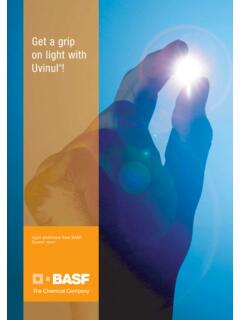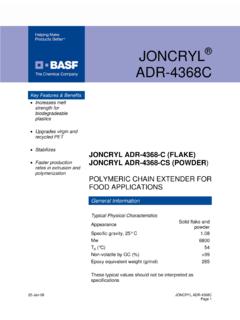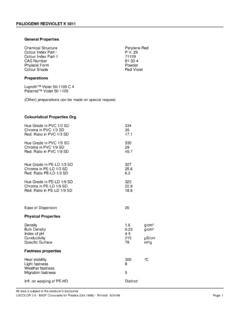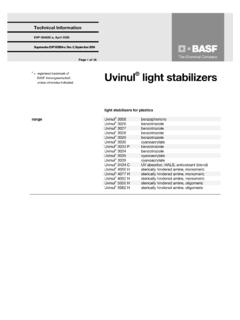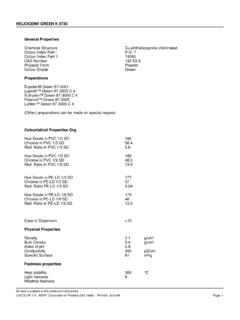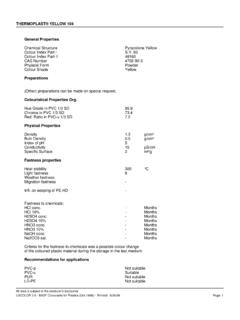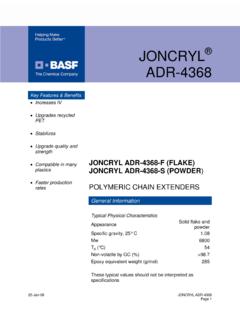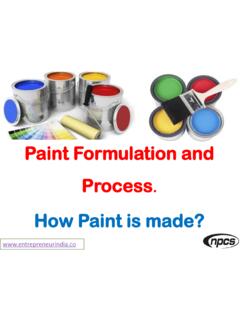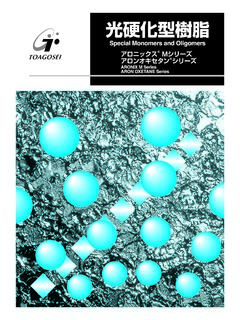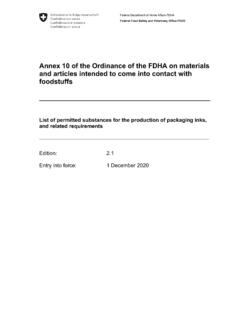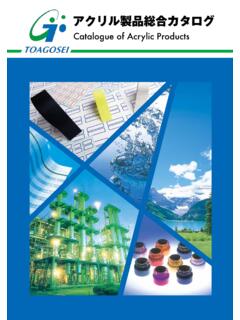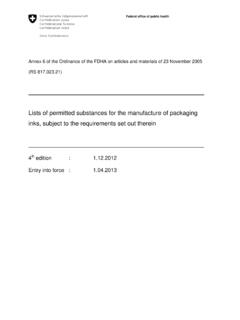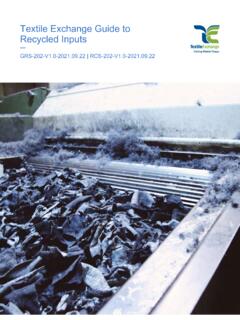Transcription of Butyl acrylate MSDS - BASF
1 Safety data sheet Butyl acrylate Revision date : 2005/10/26 Page: 1/8 Version: (30041258/MDS_GEN_US/EN) 1. Substance/preparation and company identification 24 Hour Emergency Response Information Company BASF CORPORATION 100 Campus Drive Florham Park, NJ 07932 CHEMTREC: (800) 424-9300 BASF HOTLINE: (800) 832-HELP Molecular formula: C7 H12 O2 Chemical family: organic acids, esters Synonyms: ACRYLIC ACID, Butyl ESTER 2. Composition/information on ingredients CAS Number Content (W/W) Chemical name 141-32-2 % n- Butyl acrylate 150-76-5 >= - <= PPM MEHQ 3. Hazard identification Emergency overview DANGER: FLAMMABLE LIQUID. CAUSES EYE BURNS. CAUSES SKIN BURNS. TOXIC IF ABSORBED THROUGH SKIN. CONTAINS MATERIAL THAT MAY CAUSE ADVERSE REPRODUCTIVE EFFECTS IN FEMALES.
2 SENSITIZER. CAN CAUSE LIVER DAMAGE. Use with local exhaust ventilation. Wear a NIOSH-certified (or equivalent) organic vapour/particulate respirator. Wear NIOSH-certified chemical goggles. Wear protective clothing. Eye wash fountains and safety showers must be easily accessible. Wear full face shield if splashing hazard exists. Potential health effects Primary routes of exposure Routes of entry for solids and liquids include eye and skin contact, ingestion and inhalation. Routes of entry for gases include inhalation and eye contact. Skin contact may be a route of entry for liquified gases. Acute toxicity: Harmful by inhalation. Virtually nontoxic after a single ingestion. Virtually nontoxic after a single skin contact.
3 Inhalation-risk test (IRT): Mortality within 8 hours as shown in animal studies. The inhalation of a highly saturated vapor-air mixture may represent a hazard. Irritation: Irritating to eyes, respiratory system and skin. Safety data sheet Butyl acrylate Revision date : 2005/10/26 Page: 2/8 Version: (30041258/MDS_GEN_US/EN) Sensitization: Caused sensitization in animal studies. Medical conditions aggravated by overexposure: Data available do not indicate that there are medical conditions that are generally recognized as being aggravated by exposure to this substance/product. See msds section 11 - Toxicological information. Potential environmental effects Aquatic toxicity: Acutely toxic for aquatic organisms. The inhibition of the degradation activity of activated sludge is not anticipated when introduced to biological treatment plants in appropriate low concentrations.
4 4. First-aid measures General advice: Remove contaminated clothing. If inhaled: Keep patient calm, remove to fresh air, seek medical attention. If on skin: Flush with copious amounts of water for at least 15 minutes. Sterile protective dressing. Immediate medical attention required. If in eyes: Immediately wash affected eyes for at least 15 minutes under running water with eyelids held open, consult an eye specialist. If swallowed: Immediately rinse mouth and then drink plenty of water, do not induce vomiting, seek medical attention. Never induce vomiting or give anything by mouth if the victim is unconscious or having convulsions. Note to physician Treatment: Treat according to symptoms (decontamination, vital functions), no known specific antidote, administer corticosteroid dose aerosol to prevent pulmonary odema.
5 5. Fire-fighting measures Flash point: C (DIN 51755) F (DIN 51755) Autoignition: 267 C (DIN 51794) F (DIN 51794) Lower explosion limit: %(V) ( 35 C) Upper explosion limit: %(V) ( C) Suitable extinguishing media: carbon dioxide, dry extinguishing media, water spray, foam Safety data sheet Butyl acrylate Revision date : 2005/10/26 Page: 3/8 Version: (30041258/MDS_GEN_US/EN) Hazards during fire-fighting: Risk of violent self-polymerization if overheated in a container. Protective equipment for fire-fighting: Firefighters should be equipped with self-contained breathing apparatus and turn-out gear. Further information: Vapours are heavier than air and may accumulate in low areas and travel a considerable distance up to the source of ignition.
6 Fight fire from maximum distance. NFPA Hazard codes: Health : 2 Fire: 2 Reactivity: 2 Special: 6. Accidental release measures Personal precautions: Take appropriate protective measures. Ensure adequate ventilation. Use personal protective clothing. Breathing protection required. Environmental precautions: Substance/product is RCRA hazardous due to its properties. Cleanup: Spills should be contained, solidified, and placed in suitable containers for disposal. 7. Handling and storage Handling General advice: Handle in accordance with good industrial hygiene and safety practice. The substance/ product may be handled only by appropriately trained personnel. Facility parts must be checked for polymer residues and cleaned on regular basis in order to avoid hazardous reactions.
7 Protection against fire and explosion: Heated containers should be cooled to prevent polymerization. If exposed to fire, keep containers cool by spraying with water. Emergency cooling must be provided for the eventuality of a fire in the vicinity. Sealed containers should be protected against heat as this results in pressure build-up. Avoid influence of heat. Storage General advice: Risk of polymerization. Protect against heat. Protect from direct sunlight. Protect contents from the effects of light. Avoid UV-light and other radiation with high energy. Protect against contamination. Even if the product is stored and handled as prescribed/indicated it should be used up within the indicated duration of storage. Risk of polymerization.
8 Protect from direct sunlight. Storage stability: Safety data sheet Butyl acrylate Revision date : 2005/10/26 Page: 4/8 Version: (30041258/MDS_GEN_US/EN) This product should be processed as soon as possible. Ensure adequate inhibitor and dissolved oxygen level. The product is stabilized, the shelf life should be noted. 8. Exposure controls and personal protection Components with workplace control parameters n- Butyl acrylate ACGIH TWA value 2 ppm ; MEHQ ACGIH TWA value 5 mg/m3 ; Advice on system design: Provide local exhaust ventilation to maintain recommended Personal protective equipment Respiratory protection: Wear a NIOSH-certified (or equivalent) organic vapour/particulate respirator as needed.
9 At concentrations < 250 ppm, use a chemical cartridge respirator. At concentrations > 250 ppm, use an air-supplied or self-contained breathing apparatus. Hand protection: Chemical resistant protective gloves Eye protection: Tightly fitting safety goggles (chemical goggles). Body protection: light protective clothing General safety and hygiene measures: Avoid contact with skin. Avoid inhalation of vapour. Wash soiled clothing immediately. 9. Physical and chemical properties Form: liquid Odour: ester-like, strong Colour: colourless Melting temperature: approx. -64 C : approx. F boiling temperature: approx. 148 C ( bar) (DIN 51751) : approx. F ( bar) (DIN 51751) Vapour pressure: mbar ( 20 C) mbar ( 50 C) mmHg ( F) mmHg ( F) Vapour density: Partitioning coefficient n-octanol/water (log Pow): Viscosity, dynamic: ( 20 C) (DIN/EN/ISO 3219) Solubility in water: g/l ( 20 C) Solubility (qualitative): miscible solvent(s): organic solvents, Safety data sheet Butyl acrylate Revision date : 2005/10/26 Page: 5/8 Version: (30041258/MDS_GEN_US/EN) 10.
10 Stability and reactivity Conditions to avoid: Avoid heat. Avoid oxygen content above the product of less than 5 %. Do not blanket with nitrogen. Avoid UV-light and other radiation with high energy. Avoid direct sunlight. Avoid prolonged storage. Avoid inhibitor loss. Avoid excessive temperatures. Substances to avoid: polyvinylchloride, radical formers, free radical initiators, peroxides, mercaptans, nitro-compounds, perborates, azides, ether, ketones, aldehydes, amines, nitrates, nitrites, oxidizing agent, reducing agents, strong bases, acid anhydrides, acid chlorides, concentrated mineral acids, metal salts Inert gas Hazardous reactions: Explosion and fire hazard exists under confined conditions. Ignitable air mixtures can form when the product is heated above the flash point and/or when sprayed or atomized.

